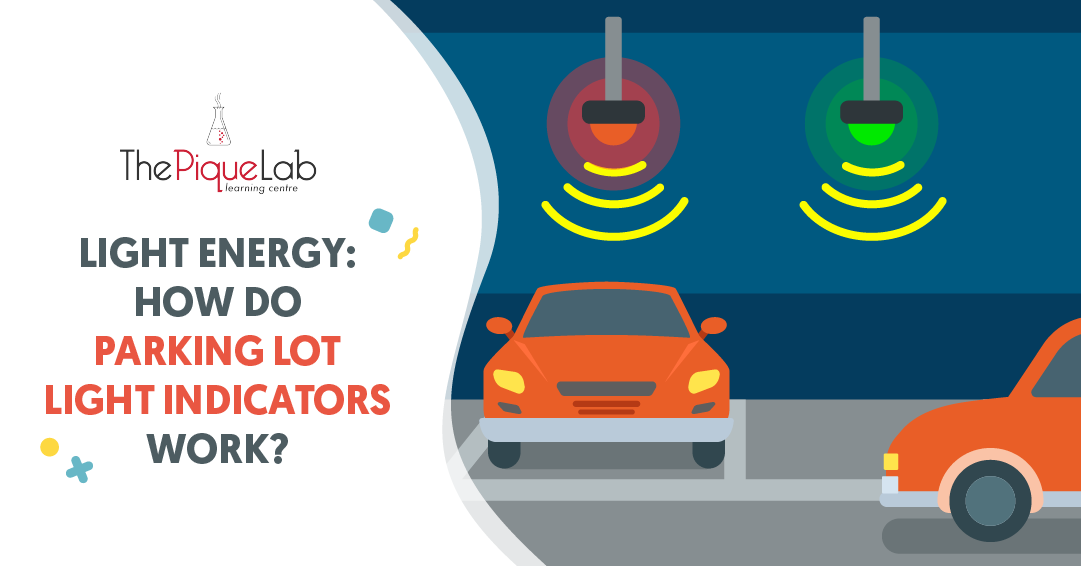Do you remember the last time you were in a carpark?
When I was younger, my parents used to set a challenge for my brother and I to spot a vacant parking lot first and the winner would be given an ice cream treat! 🍦
My strategy was to look at the row of coloured light indicators on top of the parking lots as those above vacant lots were always green and those above the occupied lots were always red.
Once a vacant parking lot was found, I realised that the light indicator above the lot would turn from green to red after the car was parked. Have you ever wondered how this happens?
Read Also:
Today, we will unravel the science behind how the parking lot light indicators change from green to red once the lot is occupied by discussing a question on Light Energy from the 2020 Methodist Girls’ School P6 Preliminary Examination.
Question Analysis

Source: Methodist Girls’ School (Primary) – 2020 P6 Prelim Examination Paper [Q34b]
This is an uncommon question that has not been widely tested recently. As students tend to panic when encountering unfamiliar questions, it’d be best for them to learn to adopt the following steps to tackle the question:
Step 1: Identify the keywords/information in the question.
Step 2: Interpret the keywords/information.
Step 3: Draw parallels to common questions that test similar concepts.
Step 1: Identify the keywords/information in the question.
- There is a light source placed on the ceiling and a light sensor placed on the floor.
- When no car is parked in between the light source and light sensor → the light indicator turns green.
- When an opaque car is parked in between the light source and light sensor → the light indicator turns red.
Step 2: Interpret the keywords/information.
After identifying that there is a light source and a light sensor in the set-up, the next question we should ask is:
“What is the function of a light source and a light sensor?”
The function of a light source is to produce light and the function of a light sensor is to detect and receive the light coming from the light source.
Next, the question informs us that the colour of the light indicator changed from green to red when an opaque car is parked between the light source and light sensor.
“Why did the light indicator change colour from green to red when the opaque car is parked in between the light source and light sensor?”
As we recall, the special property of opaque objects is that they do not allow light to pass through them. Since the car is opaque and is parked in between the light source and light sensor, the light from the light source will NOT be able to pass through the car and reach the light sensor.
Thus, the light indicator must have changed colour from green to red because the opaque car did not allow light from the light source to pass through it and reach the light sensor, causing the light sensor reading to decrease.
Hence, what do you think the red light above the parking lot indicates? The red light indicates that there is a car parked in the parking lot and the lot is now occupied!
Step 3: Draw parallels to common questions that test similar concepts.
Can you think of a common question that also makes use of the decrease in light sensor reading to indicate the presence of an object?

Source: CHIJ St. Nicholas Girls’ School (SNGS) – 2015 P4 SA2 Examination Paper [Q41]
The question above that uses a light sensor to count the number of identical objects on a moving belt should be familiar to many students. Let’s identify the similarities between both questions together!
Similarity 1
Both the moving belt and the parking lot questions involve a light source and a light sensor.

Similarity 2
“When there is no object in between the torch (light source) and light sensor, what happens in the moving belt scenario?”
There will be no objects to block light (from the torch) from reaching the light sensor. Thus, the light sensor detects all the light from the torch (light source), indicating the absence of an object.


“When there is no car in between the light source and light sensor, what happens in the parking lot scenario?”
Similar to the moving belt scenario, there will be no car to block light (from the light source) from reaching the light sensor. Thus, the light sensor detects all the light from the light source, causing the light indicator to turn green that indicates the absence of a car in the parking lot.

Similarity 3
“When there is an opaque object in between the torch (light source) and the light sensor, what happens in the moving belt scenario?”
Light from the torch (light source), which travels in a straight line, is completely blocked by the object, which is opaque. Thus, the light sensor does not detect any light from the torch (light source), indicating the presence of an object.


“When there is an opaque car in between the light source and the light sensor, what happens in the parking lot scenario?”
Similar to the moving belt scenario, light from the light source, which travels in a straight line, is completely blocked by the car, which is opaque. Thus, the light sensor does not detect any light from the light source, causing the light indicator to turn red which indicates the presence of a car in the parking lot.

The table below summarises the 3 similarities between the moving belt question and the parking lot question:

Common Mistakes
Now that we understand how parking lot light indicators work, I will summarise the key points that are commonly missing from students’ answers.
- The source of light.
Many students forget to mention the source of light in their answers.
One example is when we explain why we can see the table in the classroom – many students will answer “Light is reflected off the table into our eyes.”, which is incomplete. The complete explanation should include the light source in the classroom – “Light from the lamp (light source) is reflected off the table into our eyes.” - Light travels in a straight line.
The important property of light that causes light to be blocked is that light travels in a straight line. Thus, it is important to mention that “light travels in a straight line” before mentioning that “light is blocked”. - The transparency of the object blocking the light.
Light can be blocked by either opaque or translucent objects. Thus, it is important to specify the transparency of the object blocking the light.
Suggested Answer
By factoring in the 3 points that I’ve made above, the complete explanation is:
When the lot is unoccupied, light from the light source (1) is able to reach the light sensor, causing the light indicator to turn green.
When the lot is occupied, light from the light source (1), which travels in a straight line (2), is blocked by the car, which is opaque (3). Thus, there will be no light reaching the light sensor, causing the light indicator to turn red.
Conclusion
I hope that you have enjoyed reading this article and that you are now able to:
- Explain how the light indicator in a parking lot changes from green to red when a car parks in a vacant lot.
- Draw parallels to similar questions seen previously to tackle unfamiliar questions.
- Remember the proper keywords required when explaining questions that involve light being blocked.
Stay tuned for more articles coming your way! 🙂

If you like our methodology, we've some upcoming workshops:







